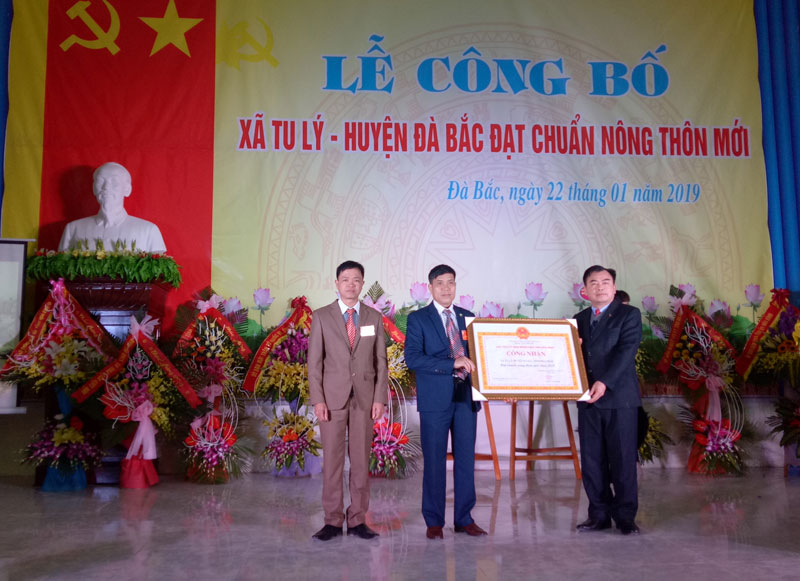
HBO – The People’s Committee of Da Bac district held a ceremony to announce Tu Ly commune’s fulfillment of all new-style rural building criteria in 2018. Attending the event was Hoang Van Duc, member of the provincial Party Committee’s Standing Board and head of the committee’s Inspection Commission.
Tu Ly is the first commune to be
recognized as a new-style rural area in Da Bac district. During eight years
(2011-2018) implementing the new-style rural area building programme, Tu Ly
commune has mobilised more than 173 billion VND to invest in infrastructure
construction and production development. Currently, the commune's transport and
irrigation systems have basically meet standards, 100 percent of local households
have regular and safe access to electricity; 92 percent of people in the working
age have regular jobs; over 70 percent of families meet cultural family criteria.
Three out of four schools in the commune have reached national standards. It
also has a cultural house and a stadium which have been newly built to serve
the commune's events.
Over the past years, locals
have actively shifted the agricultural structure towards plants and animals
with high economic value and applied science advances into production. Many
effective farming models have been duplicated, such as models of citrus and
safe vegetable growing. In addition, the commune has attached special
importance to the development of services and trade, so locals' incomes have improved
significantly. In 2018, the average per capita income reached 29 million VND
while the poverty rate of the commune reduced to 10.7 percent. Social welfare
was ensured, the material and spiritual life of local was improved, and the
political security and social order and safety stayed stable.
The provincial People's
Committee granted a certificate recognising the commune as a new-style rural
area in 2018 and awarded it with a welfare project worth 400 million VND.
At the ceremony, on behalf of
the province’s leaders, Hoang Van Duc, member of the provincial Party Committee’s
Standing Board and head of its Inspection Commission handed over the
certificate to officials and locals of Tu Ly commune.

Hoang Van Duc, member of the
provincial Party Committee’s Standing Board and head of its Inspection
Commission, presents the certificate to Tu Ly commune.
The People's Committee of Da
Bac district presented certificates of merit to 10 collectives, two enterprises,
14 households and seven individuals for their great contributions to the new-style
rural area building in Tu Ly commune in 2018./.
According to data from the Hoa Binh Provincial Party Committee, the industrial production index for the first six months of 2025 is estimated to have increased by 20% compared to the same period last year. This marks the highest year-on-year growth rate for this period since 2020.
In the first six months of 2025, Hoa Binh province’s export turnover was estimated at 1.145 billion USD, marking an 18.11% increase compared to the same period in 2024. Import turnover was estimated at $ 804 million, a 17.15% increase, which helped the province maintain a positive trade balance.
The lives of the ethnic minority farmers in Tan Lac district have gradually improved thanks to the new directions in agricultural production. This is a testament to the collective strength fostered through the professional associations and groups implemented by various levels of the district’s Farmers’ Union.
With the motto the "product quality comes first,” after nearly one year of establishment and operation, Muong village’s Clean Food Agricultural and Commercial Cooperative, located in Cau Hamlet, Hung Son Commune (Kim Boi district), has launched reputable, high-quality agricultural products to the market that are well-received by consumers. The products such as Muong village’s pork sausage, salt-cured chicken, and salt-cured pork hocks have gradually carved out a place in the market and they are on the path to obtaining the OCOP certification.
In the past, the phrase "bumper harvest, rock-bottom prices" was a familiar refrain for Vietnamese farmers engaged in fragmented, small-scale agriculture. But today, a new spirit is emerging across rural areas of Hoa Binh province - one of collaboration, organisation, and collective economic models that provide a stable foundation for production.
Maintaining growing area codes and packing facility codes in accordance with regulations is a mandatory requirement for agricultural products to be eligible for export. Recently, the Department of Agriculture and Environment of Hoa Binh province has intensified technical supervision of designated farming areas and packing facilities to safeguard the "green passport" that enables its products to access international markets.



